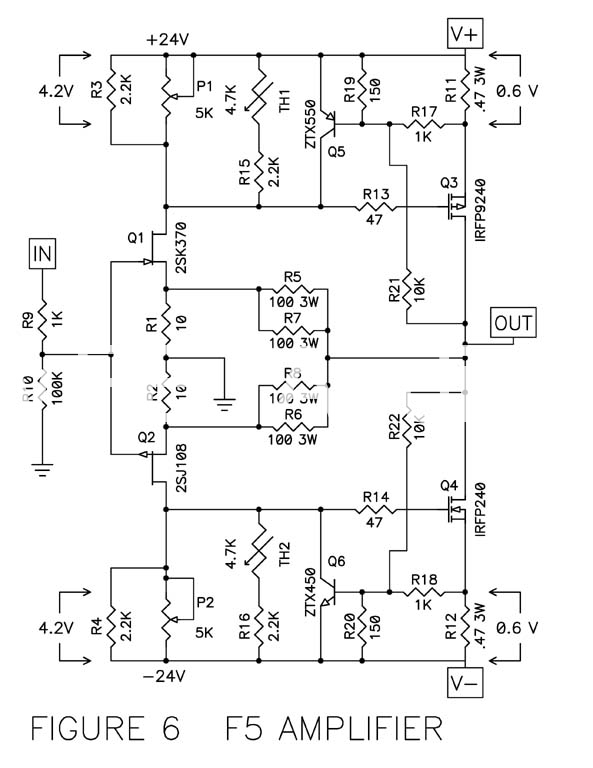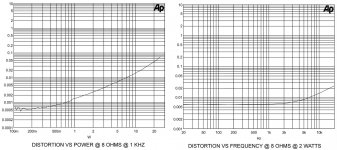Ok ive just had a letting go of the magic smoke R15 2.2k has burnt turned off as soon as i heard. Ok so i can replace but why did it go? and with this failing will other components have been damaged?
Any help appreciated
Any help appreciated
R15 2.2k has burnt turned off as soon as i heard. Ok so i can replace but why did it go?
and with this failing will other components have been damaged?
This is a symptom, not a cause. Check all parts and connections.
This is a symptom, not a cause. Check all parts and connections.
yes I realise that just wanted to know any obvious pointers..if there were any
Hello Guys.
I'm currently looking for replace my tweeter amp by a F5.
today I perform some measurements using REW and looks that THD of F5 is very similar
to my P3A even if it runs in class AB mode.
I had the F5 on a good heatsink, using a laboratory power supply at 23v with biasing of 1.3 amp per mosfet.
I used my sweet satori tweeter.
so at 78db 1 meter
F5
1khz - thd 0.637% (with 0.593% 2nd)
3khz - thd 0.193%
5khz - thd 0.192%
P3A
1khz - thd 0.546% (with 0.502% 2nd)
3khz - thd 0.202%
5khz - thd 0.200%
my P3A isn't looking so bad.
So I'd like to know if there is any on my rew results that says that the F5 will be better.
A read somewhere that a class A amp is better at dynamics.. how can I test that?
Thanks
that's the link to the results
https://drive.google.com/file/d/0B3xomxxJGG7FX0Itd0tCdnVSZmc/view?usp=sharing
I'm currently looking for replace my tweeter amp by a F5.
today I perform some measurements using REW and looks that THD of F5 is very similar
to my P3A even if it runs in class AB mode.
I had the F5 on a good heatsink, using a laboratory power supply at 23v with biasing of 1.3 amp per mosfet.
I used my sweet satori tweeter.
so at 78db 1 meter
F5
1khz - thd 0.637% (with 0.593% 2nd)
3khz - thd 0.193%
5khz - thd 0.192%
P3A
1khz - thd 0.546% (with 0.502% 2nd)
3khz - thd 0.202%
5khz - thd 0.200%
my P3A isn't looking so bad.
So I'd like to know if there is any on my rew results that says that the F5 will be better.
A read somewhere that a class A amp is better at dynamics.. how can I test that?
Thanks
that's the link to the results
https://drive.google.com/file/d/0B3xomxxJGG7FX0Itd0tCdnVSZmc/view?usp=sharing
Last edited:
read somewhere that a class A amp is better at dynamics.. how can I test that?
Listen to it, but with a proper, internally installed power supply.
Listen to it, but with a proper, internally installed power supply.
Thanks, but I'm looking for tests I can do now before the investment of a chassis and a proper psu as they are the biggest investments.
Thanks, but I'm looking for tests I can do now before
the investment of a chassis and a proper psu as they are the biggest investments.
You can't predict a lot about the sound of an amplifier from measurements, and the
power supply is a big part of the sound.
These are the standard measurements for the F5. It would appear that
your F5 is not behaving as designed, or perhaps you are simply reading
the tweeter's distortion figure.
Yes, the majority of those numbers are the tweeter distortion.
I was looking to check how the F5 would perform with my Satori tweeter.
Thanks
Hello Guys.
I'm currently looking for replace my tweeter amp by a F5.
today I perform some measurements using REW and looks that THD of F5 is very similar
to my P3A even if it runs in class AB mode.
I had the F5 on a good heatsink, using a laboratory power supply at 23v with biasing of 1.3 amp per mosfet.
I used my sweet satori tweeter.
so at 78db 1 meter
F5
1khz - thd 0.637% (with 0.593% 2nd)
3khz - thd 0.193%
5khz - thd 0.192%
P3A
1khz - thd 0.546% (with 0.502% 2nd)
3khz - thd 0.202%
5khz - thd 0.200%
my P3A isn't looking so bad.
So I'd like to know if there is any on my rew results that says that the F5 will be better.
A read somewhere that a class A amp is better at dynamics.. how can I test that?
Thanks
that's the link to the results
https://drive.google.com/file/d/0B3xomxxJGG7FX0Itd0tCdnVSZmc/view?usp=sharing
Just clarify these THD numbers are the number of F5 driving a tweeter.
and they were measured a software called REW using a calibrated usb microphone.
Ok ive just had a letting go of the magic smoke R15 2.2k has burnt turned off as soon as i heard. Ok so i can replace but why did it go? and with this failing will other components have been damaged?
Any help appreciated
This one has a 2.2k R15 -

Normally current through R15 goes to the jFET.
If it has burnt out then then current must have gone somewhere else.
Could the Gate to Drain in the output mosFET have gone shorted?
compare the distortions of the two amplifiers.Just clarify these THD numbers are the number of F5 driving a tweeter.
and they were measured a software called REW using a calibrated usb microphone.
compare the distortions of the two amplifiers.
Hello Andrew, I did compare with a P3A and Behringer A500. the THD graph for F5 and P3A looks much better than the one for A500.
F5 THD
[image]F5 THD|F5 THD[/image]
P3A THD
[image]P3A THD|P3A THD[/image]
Berhinger A500 THD
[image]behringer-a500 THD|Berhinger A500 THD[/image]
ps. Tweeter driven by those amps : Satori TW29R Ring Dome
Microphone used : UMIK-1
Why do your plots compare tweeter distortions when you should be comparing amplifier distortions?
It would be OK to compare amplifier distortions with a resistive dummy load and/or with a simulated and reactive dummy load and/or with a real tweeter as a load. But in all cases you should be measuring amplifier performance not tweeter performance.
It would be OK to compare amplifier distortions with a resistive dummy load and/or with a simulated and reactive dummy load and/or with a real tweeter as a load. But in all cases you should be measuring amplifier performance not tweeter performance.
Why do your plots compare tweeter distortions when you should be comparing amplifier distortions?
It would be OK to compare amplifier distortions with a resistive dummy load and/or with a simulated and reactive dummy load and/or with a real tweeter as a load. But in all cases you should be measuring amplifier performance not tweeter performance.
I understant, but at end I will use a amp with this driver so to me is very important to figure out
how it would perfom. at end the interaction amp vs driver is the most important aspect IMO.
This these tests I was able to verify that F5 performs better then a A500 using the same Tweeter.
Thanks
That's an acoustic measurement, right? If so, you are seeing mainly the distortion of your speaker + microphone.Hello Guys.
I'm currently looking for replace my tweeter amp by a F5.
today I perform some measurements using REW and looks that THD of F5 is very similar
to my P3A even if it runs in class AB mode.
I had the F5 on a good heatsink, using a laboratory power supply at 23v with biasing of 1.3 amp per mosfet.
I used my sweet satori tweeter.
so at 78db 1 meter
F5
1khz - thd 0.637% (with 0.593% 2nd)
3khz - thd 0.193%
5khz - thd 0.192%
P3A
1khz - thd 0.546% (with 0.502% 2nd)
3khz - thd 0.202%
5khz - thd 0.200%
my P3A isn't looking so bad.
So I'd like to know if there is any on my rew results that says that the F5 will be better.
A read somewhere that a class A amp is better at dynamics.. how can I test that?
Thanks
that's the link to the results
https://drive.google.com/file/d/0B3xomxxJGG7FX0Itd0tCdnVSZmc/view?usp=sharing
That's an acoustic measurement, right? If so, you are seeing mainly the distortion of your speaker + microphone.
yes, the majority of distortion is from the driver.
however if check my results using a A500 amp you can see clearly
that the F5 and the P3A have a much better distortion profile.
Thanks
- Home
- Amplifiers
- Pass Labs
- F5 power amplifier
